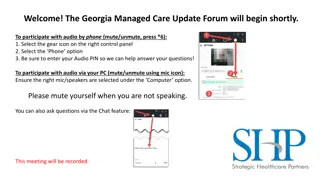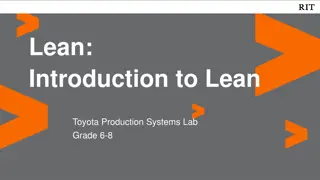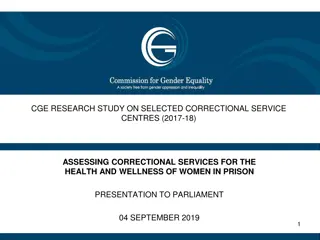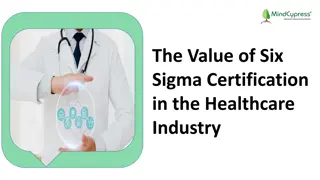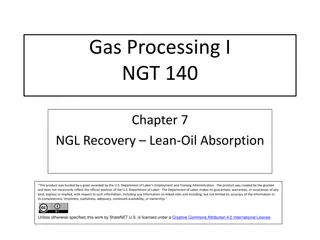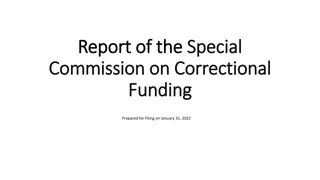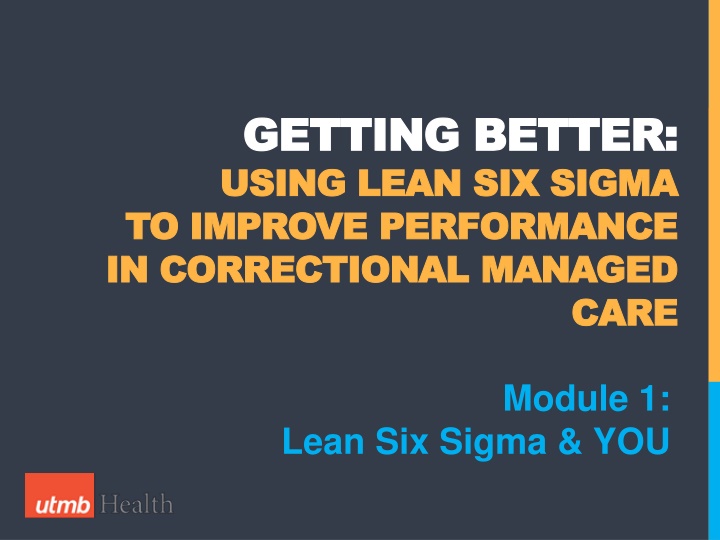
Using Lean Six Sigma to Improve Performance in Correctional Managed Care
Enhance performance in correctional managed care by applying Lean Six Sigma methodologies. This module provides insights into improving operational efficiency, quality, and patient outcomes. Learn how to implement Lean Six Sigma principles effectively in a correctional healthcare setting to drive continuous improvement and ensure better results.
Download Presentation

Please find below an Image/Link to download the presentation.
The content on the website is provided AS IS for your information and personal use only. It may not be sold, licensed, or shared on other websites without obtaining consent from the author. If you encounter any issues during the download, it is possible that the publisher has removed the file from their server.
You are allowed to download the files provided on this website for personal or commercial use, subject to the condition that they are used lawfully. All files are the property of their respective owners.
The content on the website is provided AS IS for your information and personal use only. It may not be sold, licensed, or shared on other websites without obtaining consent from the author.
E N D
Presentation Transcript
GETTING BETTER: GETTING BETTER: USING LEAN SIX SIGMA USING LEAN SIX SIGMA TO IMPROVE PERFORMANCE TO IMPROVE PERFORMANCE IN CORRECTIONAL MANAGED IN CORRECTIONAL MANAGED CARE CARE Module 1: Lean Six Sigma & YOU
LEARNING OBJECTIVES FOR MODULE 1 After completing Module 1, you should be able to: Describe why continuous performance improvement methods & strategies are needed in prison healthcare systems Describe why Lean Six Sigma is the clear choice for continuous performance improvement in CMC Describe the implementation of the Lean Six Sigma program in CMC to date
A CHALLENGE TO PRISON HEALTHCARE SYSTEMS Prison healthcare systems must continue to provide high quality healthcare to their patients in the face of: Increasing need Patients are older Patients are sicker Rising healthcare costs Decreased or static funds
THE NEED FOR CONTINUOUS PERFORMANCE IMPROVEMENT Continuous performance improvement methods & strategies are needed in correctional healthcare settings to Reduce waste Improve efficiency Reduce errors Improve quality/outcomes Contain costs
WHAT IS LEAN SIX SIGMA? Continuous process improvement approach Structured problem-solving framework Fact-based, data-driven decision-making methodology Business excellence philosophy Kovach, J. V. UH-COT Lean Six Sigma Green Belt Training Manual (www.tech.uh.edu/sixsigma); 2012.
WHAT IS LEAN SIX SIGMA? A combination of Lean & Six Sigma, which are two different but complementary approaches to continuous performance improvement Lean emphasizes waste reduction & efficiency Six Sigma emphasizes consistency & effectiveness Lean efficiency + Six Sigma effectiveness = Improved Performance
WHY LEAN SIX SIGMA? Lean Six Sigma offers a more comprehensive and prescriptive methodology than other performance improvement approaches Good, strong evidence that Lean Six Sigma helps improve efficiency & effectiveness while reducing costs specifically in healthcare services delivery
WHY LEAN SIX SIGMA? Consistently reported to improve efficiency in healthcare services delivery OR throughput (planning, scheduling, anesthesia techniques, physician arrival times, surgery duration, etc.) ED throughput (wait times, triage, lab and radiology turnaround, bed availability, registration and discharge procedures, staffing patterns, etc.) -DelliFraine JL, Langabeer JR, Nembhard IM. Assessing the evidence of Six Sigma and Lean in the health care industry. Q Manage Health Care. 2010; 19(3): 211-255. -Vest JR, Gamm LD. A critical review of the research literature on Six Sigma, Lean and StuderGroup s Hardwiring Excellence in the United States: the need to demonstrate and communicate the effectiveness of transformation strategies in healthcare. Implementation Science. 2009; 4 (35): 1-9.
WHY LEAN SIX SIGMA? Consistently reported to improve effectiveness of healthcare services Reducing medication errors (medication type, dose, frequency, schedule, route, etc.) Reducing post-surgical and hospital-acquired infections (antibiotic prophylaxis, hygiene practices, etc.) -DelliFraine JL, Langabeer JR, Nembhard IM. Assessing the evidence of Six Sigma and Lean in the health care industry. Q Manage Health Care. 2010; 19(3): 211-255. -Vest JR, Gamm LD. A critical review of the research literature on Six Sigma, Lean and StuderGroup s Hardwiring Excellence in the United States: the need to demonstrate and communicate the effectiveness of transformation strategies in healthcare. Implementation Science. 2009; 4 (35): 1-9.
WHY LEAN SIX SIGMA? Consistently reported as effective in reducing costs and increasing revenue Decreasing operational costs Decreasing length of stay Increasing surgical volume -DelliFraine JL, Langabeer JR, Nembhard IM. Assessing the evidence of Six Sigma and Lean in the health care industry. Q Manage Health Care. 2010; 19(3): 211-255. -Vest JR, Gamm LD. A critical review of the research literature on Six Sigma, Lean and StuderGroup s Hardwiring Excellence in the United States: the need to demonstrate and communicate the effectiveness of transformation strategies in healthcare. Implementation Science. 2009; 4 (35): 1-9.
WHY LEAN SIX SIGMA? Although Lean Six Sigma (LSS, hereafter) was originally developed for manufacturing/industry, it is being increasingly used and fully integrated into healthcare systems Many major healthcare systems and hospitals have entire departments dedicated to performance improvement using LSS MD Anderson Cancer Center Memorial Hermann Healthcare System Virginia Mason Medical Center Mayo Clinic New York Presbyterian Hospital Johns Hopkins Hospital
WHY NOW? CMC is in an excellent position to promote a comprehensive LSS performance improvement program Strong electronic data systems and frameworks (e.g., EMR and CMC Dashboard) may be used to identify problems and measure impact of improvements Strong endorsement from CMC leadership Shared performance improvement philosophy and approach with UTMB's increasing emphasis on Lean Management Systems TDCJ leadership generally supportive
WHY YOU? Successful implementation of an LSS program requires that Communication pathways allow improvement ideas to come from all sectors of the organization ideas bubble up as well as trickle down Leadership and staff have reasonable and shared expectations Selection of improvement projects is guided by the mission, vision, and financial bottom line of the organization So, EVERYONE, from executive leadership to frontline staff, will be educated about & engaged in LSS continuous performance improvement
LSS EDUCATION IN CMC: WHAT HAVE WE DONE SO FAR? Through a collaborative effort of the University of Houston School of Technology and the University of Texas School of Public Health, CMC has had several multi-disciplinary cohorts of CMC staff members have received LSS Green Belt Training consisting of: In-person classroom trainings to discuss and practice the implementation of LSS tools and frameworks in a group setting Taking and passing the LSS Green Belt written exam Presenting reviews of their completed projects to faculty of both CMC and University of Houston for full Green Belt certification *See the CMC LSS website or list of Certified Training Specialists
LSS EDUCATION IN CMC: WHAT HAVE WE DONE SO FAR? Developed a comprehensive, 6-module on-line LSS course for managers Developed a 7-module on-line LSS training for all staff levels Developed and delivered a 4-hour classroom training specifically tailored for executive and senior leadership Developed and continue to deliver a 2-day classroom training for managers, which now includes training on Leadership Development
TEAMWORK IN THE CLASSROOM! The Marshmallow Exercise Region 1 Beeville Club House The Numbers Game Region 2 Ferguson Club House
LSS EDUCATION IN CMC: WHAT ARE WE DOING NEXT? Planning for refresher & advanced on-line modules and classes for all staff levels Continue Green Belt training for select cohorts of multi-disciplinary teams Black Belt training for select Green Belts
COMPLETED LSS GREEN BELT IMPROVEMENT PROJECTS Green Belt trainees have initiated and successfully completed projects such as: Reducing Current and Future EMR Reports Using Lean Six Sigma to Reduce Utilization Review Call Center Wait Times Improving TB Screening Rates at an Intake Facility Improving Follow-up Appointment Scheduling for Specialty Clinics at Hospital Galveston Reducing Overdue Medical and Nursing Reminders Reducing Overdue Reminders for Chronic Care Clinic Appointments Improving the No-Show Rate for HG clinics
MANAGER TEAM PROJECTS All manager teams that participated in an LSS classroom training-initiated improvement projects, addressing a range of issues, such as Reducing no show rates Improving medication transfer unit to unit Improving/streamlining the sick call triage process Improving efficiency and effectiveness of flosser distribution process Reducing patient wait times Reducing the percent of patients arriving at HG but not being seen Improving patient throughput in the unit clinics Reducing shipping errors on expensive meds Improving and tracking workers compensation processes Improving hypertension control Results from some of the completed projects are shown in the next several slides
REDUCTION IN NO SHOW RATES The graph below shows three facilities achieved and maintained 0% no show rates
IMPACT OF REDUCTIONS IN NO SHOW RATES Reducing no show rates matters because No shows result in waste through duplication of effort (i.e., patients have to be rescheduled, etc.) Recent analyses indicate that each no show may cost between $49 and $53 Throughout our outpatient clinics this FYTD, we had approximately 68K no shows (all disciplines) Eliminating no shows could save an estimated between $3.4 million and $3.6 million in duplicated services
LINDSEY UNIT HYPERTENSION CONTROL The team at the Lindsey Unit was able to raise and maintain the rate of controlled hypertension among their patients <60 years of age 100 90 75 80 76 76 75 70 68 67 68 64 60 60 51 50 50 Post-Improvement Average = 71% 43 40 30 Baseline Average = 51% 20 10 0
HOLLIDAY UNIT OVERDUE CHRONIC CARE REMINDERS The team at the Holliday Unit was able to reduce the number of overdue chronic care reminders and to maintain that reduction 700 600 500 432 386 368 354 400 Post-Improvement Average = 121 300 168 200 140 134120 126 114 Baseline Average = 90 78 100 0
HUGHES UNIT FLOSSER DISTRIBUTION The team at the Hughes Unit changed the flosser distribution process from one based on a sick call request to one based on a regularly scheduled flosser clinic, resulting in a time savings of 22 minutes per day or about 92 hours per year. 60 52 50 40 30 30 Before After 20 8.7 10 7 6 2 0 Avg Total Daily Minutes Avg Minutes per Encounter Avg Daily # Sick Calls
Crain Unit Narcotics Management The team at the Crain Unit was able to reduce the number of satellites where narcotics were distributed, thereby substantially reducing the time, motion, and personnel effort associated with narcotics management on the unit
LSS ENGAGEMENT IN CMC: WHAT ARE WE DOING NEXT? Prioritize strategic objectives to guide selection of targets & organization of staff for performance improvement efforts Continue to integrate and showcase utilization of LSS methods on unit-based performance improvement initiatives Discuss, delineate, & document best practices for specific processes (e.g., maintaining low no show rates) Initiate discipline-specific discussions to address issues and identify best practices (e.g., flosser distribution) Collaborate with TDCJ on system-wide, highest priority issues
TAKEAWAYS Given increased needs and rising healthcare costs, performance improvement methods and strategies are needed in prison healthcare systems. Lean Six Sigma is a systematic performance improvement approach that is being widely used in healthcare systems throughout the country. Evidence demonstrates that Lean Six Sigma methods and strategies can be used to improve both the effectiveness and efficiency of healthcare services delivery. Successful Lean Six Sigma programs depend on commitment, communication, and collaboration of every member of the organization.




